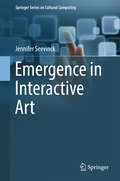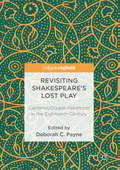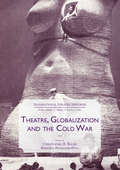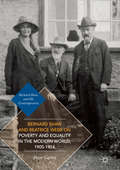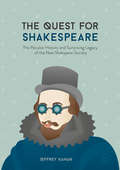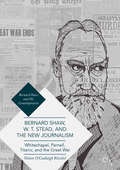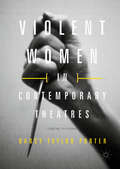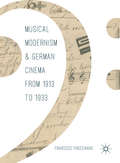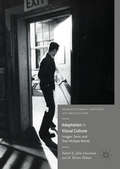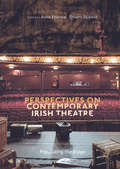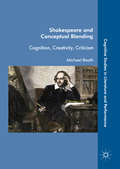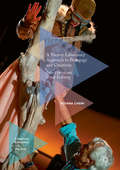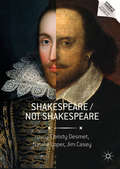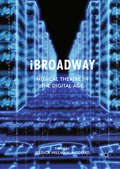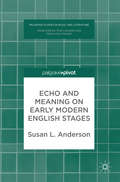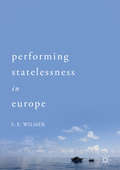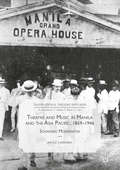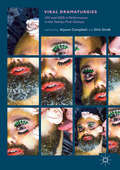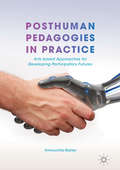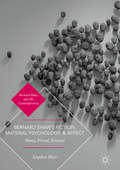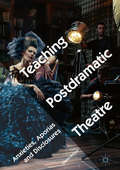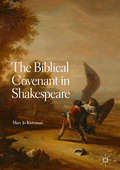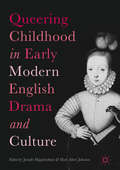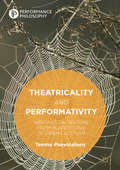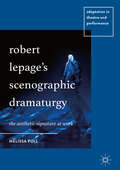- Table View
- List View
Emergence in Interactive Art
by Jennifer SeevinckThis book is concerned with emergence, interaction, art and computing. It introduces a new focus for emergence in interactive art: the emergent experience. Emergence literature is discussed and an organising framework, the Taxonomy of Emergence in Interactive Art (TEIA) is provided together with case studies of digital, interactive art systems that facilitate emergence. Evidence from evaluations of people interacting with the works is analysed using the TEIA. Artworks from across the world are also reviewed to further illustrate the potential for emergence. Interactive art is, itself, still a young domain where audience influence, or interaction with the work is a defining aspect. Emergence in Interactive Art explores the rich opportunities for interactive experiences of digital art systems that are provided by looking through a 'lens' of emergence. And what better way to explore these potentials than through the open-ended domain of emergence, with its inherent affinity to the natural world? Through an integrated approach of practice, research and theory this book reveals design and analytical insights relating to emergence, interaction and interactive art to benefit artists, researchers and designers alike.
Revisiting Shakespeare’s Lost Play
by Deborah C. PayneThis collection of essays centres on Double Falsehood, Lewis Theobald's 1727 adaptation of the "lost" play of Cardenio, possibly co-authored by John Fletcher and William Shakespeare. In a departure from most scholarship to date, the contributors fold Double Falsehood back into the milieu for which it was created rather than searching for traces of Shakespeare in the text. Robert D. Hume's knowledge of theatre history permits a fresh take on the forgery question as well as the Shakespeare authorship controversy. Diana Solomon's understanding of eighteenth-century rape culture and Jean I. Marsden's command of contemporary adaptation practices both emphasise the play's immediate social and theatrical contexts. And, finally, Deborah C. Payne's familiarity with the eighteenth-century stage allows for a reconsideration of Double Falsehood as integral to a debate between Theobald, Alexander Pope, and John Gay over the future of the English drama.
Theatre, Globalization and the Cold War
by Christopher B. Balme Berenika Szymanski-DüllThis book examines how the Cold War had a far-reaching impact on theatre by presenting a range of current scholarship on the topic from scholars from a dozen countries. They represent in turn a variety of perspectives, methodologies and theatrical genres, including not only Bertolt Brecht, Jerzy Grotowski and Peter Brook, but also Polish folk-dancing, documentary theatre and opera production. The contributions demonstrate that there was much more at stake and a much larger investment of ideological and economic capital than a simple dichotomy between East versus West or socialism versus capitalism might suggest. Culture, and theatrical culture in particular with its high degree of representational power, was recognized as an important medium in the ideological struggles that characterize this epoch. Most importantly, the volume explores how theatre can be reconceptualized in terms of transnational or even global processes which, it will be argued, were an integral part of Cold War rivalries.
Bernard Shaw and Beatrice Webb on Poverty and Equality in the Modern World, 1905–1914 (Bernard Shaw and His Contemporaries)
by Peter GahanThis book investigates how, alongside Beatrice Webb's ground-breaking pre- World War One anti-poverty campaigns, George Bernard Shaw helped launch the public debate about the relationship between equality and democracy in a developed economy. The ten years following his great 1905 play on poverty Major Barbara present a puzzle to Shaw scholars, who have hitherto failed to appreciate both the centrality of the idea of equality in major plays like Getting Married, Misalliance, and Pygmalion, and to understand that his major political work, 1928's The Intelligent Woman's Guide to Socialism and Capitalism had its roots in this period before the Great War. As both the era's leading dramatist and leader of the Fabian Society, Shaw proposed his radical postulate of equal incomes as a solution to those twin scourges of a modern industrial society: poverty and inequality. Set against the backdrop of Beatrice Webb's famous Minority Report of the Royal Commission on the Poor Law 1905-1909 - a publication which led to grass-roots campaigns against destitution and eventually the Welfare State - this book considers how Shaw worked with Fabian colleagues, Sidney and Beatrice Webb, and H. G. Wells to explore through a series of major lectures, prefaces and plays, the social, economic, political, and even religious implications of human equality as the basis for modern democracy.
The Quest for Shakespeare
by Jeffrey KahanThis book traces the formation and impact of the New Shakspeare Society, created in 1873, which dedicated itself to solving the mysteries of Shakespeare's authorship by way of science. This promise, however, was undermined not only by the antics of its director, Frederick J. Furnivall, but also by the inexactitudes of the tests. Jeffrey Kahan puzzles out how a society geared towards science quickly devolved into a series of grudge matches. Nonetheless, the New Shakspere Society set the bibliographical and biographical agenda for the next century--an unusual legacy for an organization that was rife with intrigue, enmity, and incompetence; lives were ruined, lawyers consulted, and scholarship (mostly bad) produced and published.
Bernard Shaw, W. T. Stead, and the New Journalism
by Nelson O'Ceallaigh RitschelThis book explores Bernard Shaw’s journalism from the mid-1880s through the Great War—a period in which Shaw contributed some of the most powerful and socially relevant journalism the western world has experienced. In approaching Shaw’s journalism, the promoter and abuser of the New Journalism, W. T. Stead, is contrasted to Shaw, as Shaw countered the sensational news copy Stead and his disciples generated. To understand Shaw’s brand of New Journalism, his responses to the popular press’ portrayals of high profile historical crises are examined, while other examples prompting Shaw’s journalism over the period are cited for depth: the 1888 Whitechapel murders, the 1890-91 O’Shea divorce scandal that fell Charles Stewart Parnell, peace crusades within militarism, the catastrophic Titanic sinking, and the Great War. Through Shaw’s journalism that undermined the popular press’ shock efforts that prevented rational thought, Shaw endeavored to promote clear thinking through the immediacy of his critical journalism. Arguably, Shaw saved the free press.
Violent Women in Contemporary Theatres
by Nancy Taylor PorterThis book brings together the fields of theatre, gender studies, and psychology/sociology in order to explore the relationships between what happens when women engage in violence, how the events and their reception intercept with cultural understandings of gender, how plays thoughtfully depict this topic, and how their productions impact audiences. Truthful portrayals force consideration of both the startling reality of women's violence -- not how it's been sensationalized or demonized or sexualized, but how it is -- and what parameters, what possibilities, should exist for its enactment in life and live theatre. These women appear in a wide array of contexts: they are mothers, daughters, lovers, streetfighters, boxers, soldiers, and dominatrixes. Who they are and why they choose to use violence varies dramatically. They stage resistance and challenge normative expectations for women. This fascinating and balanced study will appeal to anyone interested in gender/feminism issues and theatre.
Musical Modernism and German Cinema from 1913 to 1933
by Francesco FinocchiaroThis book investigates the relationship between musical Modernism and German cinema. It paves the way for anunorthodox path of research, one which has been little explored up until now. The main figures of musical Modernism, from Alban Berg to Paul Hindemith, and from Richard Strauss to Kurt Weill, actually had a significant relationship with cinema. True, it was a complex and contradictory relationship in which cinema often emerged more as an aesthetic point of reference than an objective reality; nonetheless, the reception of the language and aesthetic of cinema had significant influence on the domain of music. Between 1913 and 1933, Modernist composers' exploration of cinema reached such a degree of pervasiveness and consistency as to become a true aesthetic paradigm, a paradigm that sat at the very heart of the Modernist project. In this insightful volume, Finocchiaro shows that the creative confrontation with the avant-garde medium par excellence can be regarded as a vector of musical Modernism: a new aesthetic paradigm for the very process - of deliberate misinterpretation, creative revisionism, and sometimes even intentional subversion of the Classic-Romantic tradition - which realized the "dream of Otherness" of the Modernist generation.
Adaptation in Visual Culture: Images, Texts, and Their Multiple Worlds (Palgrave Studies in Adaptation and Visual Culture)
by R. Barton Palmer Julie GrossmanThis book offers the first comprehensive discussion of the relationship between Modern Irish Literature and the Irish cinema, with twelve chapters written by experts in the field that deal with principal films, authors, and directors. This survey outlines the influence of screen adaptation of important texts from the national literature on the construction of an Irish cinema, many of whose films because of cultural constraints were produced and exhibited outside the country until very recently. Authors discussed include George Bernard Shaw, Oscar Wilde, Liam O'Flaherty, Christy Brown, Edna O'Brien, James Joyce, and Brian Friel. The films analysed in this volume include THE QUIET MAN, THE INFORMER, MAJOR BARBARA, THE GIRL WITH GREEN EYES, MY LEFT FOOT, THE PICTURE OF DORIAN GRAY, THE SNAPPER, and DANCING AT LUGHNASA. The introduction features a detailed discussion of the cultural and political questions raised by the promotion of forms of national identity by Ireland's literary and cinematic establishments.
Perspectives on Contemporary Irish Theatre
by Anne Etienne Thierry DubostThis book addresses the notion posed by Thomas Kilroy in his definition of a playwright's creative process: 'We write plays, I feel, in order to populate the stage'. It gathers eclectic reflections on contemporary Irish theatre from both Irish theatre practitioners and international academics. The eighteen contributions offer innovative perspectives on Irish theatre since the early 1990s up to the present, testifying to the development of themes explored by emerging and established playwrights as well as to the (r)evolutions in practices and approaches to the stage that have taken place in the last thirty years. This cross-disciplinary collection devotes as much attention to contextual questions and approaches to the stage in practice as it does to the play text in its traditional and revised forms. The essays and interviews encourage dialectic exchange between analytical studies on contemporary Irish theatre and contributions by theatre practitioners.
Shakespeare and Conceptual Blending
by Michael BoothThis book shows how Shakespeare's excellence as storyteller, wit and poet reflects the creative process of conceptual blending. Cognitive theory provides a wealth of new ideas that illuminate Shakespeare, even as he illuminates them, and the theory of blending, or conceptual integration, strikingly corroborates and amplifies both classic and current insights of literary criticism. This study explores how Shakespeare crafted his plots by fusing diverse story elements and compressing incidents to strengthen dramatic illusion; considers Shakespeare's wit as involving sudden incongruities and a reckoning among differing points of view; interrogates how blending generates the "strange meaning" that distinguishes poetic expression; and situates the project in relation to other cognitive literary criticism. This book is of particular significance to scholars and students of Shakespeare and cognitive theory, as well as readers curious about how the mind works.
A Theatre Laboratory Approach to Pedagogy and Creativity: Odin Teatret and Group Learning (Creativity, Education and the Arts)
by Tatiana ChemiThis book considers the pedagogy of the theatre laboratory, focusing on seminal theatre group Odin Teatret. It provides a detailed discussion of the historical background to theatre laboratories, including their conception, before moving on to specific examples of how the work at Odin Teatret crosscuts creativity, pedagogy, and research practices. The book draws on a range of insightful sources, including historical readings and previous literature, interviews with members of the theatre group, autoethnographic pieces, and personal experiences. Its unique narrative brings fresh insights into how to establish inquiry-based learning laboratories, in order to re-think higher education. It will be an invaluable resource for students and academics working on performance, creativity studies and pedagogy.
Shakespeare / Not Shakespeare
by Christy Desmet Natalie Loper Jim CaseyThis essay collection addresses the paradox that something may at once "be" and "not be" Shakespeare. This phenomenon can be a matter of perception rather than authorial intention: audiences may detect Shakespeare where the author disclaims him or have difficulty finding him where he is named. Douglas Lanier's "Shakespearean rhizome," which co-opts Deleuze and Guattari's concept of artistic relations as rhizomes (a spreading, growing network that sprawls horizontally to defy hierarchies of origin and influence) is fundamental to this exploration. Essays discuss the fine line between "Shakespeare" and "not Shakespeare" through a number of critical lenses--networks and pastiches, memes and echoes, texts and paratexts, celebrities and afterlives, accidents and intertexts--and include a wide range of examples: canonical plays by Shakespeare, historical figures, celebrities, television performances and adaptations, comics, anime appropriations, science fiction novels, blockbuster films, gangster films, Shakesploitation and teen films, foreign language films, and non-Shakespearean classic films.
iBroadway: Musical Theatre in the Digital Age
by Jessica Hillman-McCordThis book argues that the digital revolution has fundamentally altered the way musicals are produced, followed, admired, marketed, reviewed, researched, taught, and even cast. In the first hundred years of its existence, commercial musical theatre functioned on one basic model. However, with the advent of digital and network technologies, every musical theatre artist and professional has had to adjust to swift and unanticipated change. Due to the historically commercial nature of the musical theatre form, it offers a more potent test case to reveal the implications of this digital shift than other theatrical art forms. Rather than merely reflecting technological change, musical theatre scholarship and practice is at the forefront of the conversation about art in the digital age. This book is essential reading for musical theatre fans and scholars alike.
Echo and Meaning on Early Modern English Stages
by Susan L. AndersonThis book examines the trope of echo in early modern literature and drama, exploring the musical, sonic, and verbal effects generated by forms of repetition on stage and in print. Focusing on examples where Echo herself appears as a character, this study shows how echoic techniques permeated literary, dramatic, and musical performance in the period, and puts forward echo as a model for engaging with sounds and texts from the past. Starting with sixteenth century translations of myths of Echo from Ovid and Longus, the book moves through the uses of echo in Elizabethan progress entertainments, commercial and court drama, Jacobean court masques, and prose romance. It places the work of well-known dramatists, such as Ben Jonson and John Webster, in the context of broader cultures of performance. The book will be of interest to scholars and students of early modern drama, music, and dance.
Performing Statelessness in Europe
by S. E. WilmerThis book examines performative strategies that contest nationalist prejudices in representing the conditions of refugees, the stateless and the dispossessed. In the light of the European Union failing to find a political solution to the current migration crisis, it considers a variety of artistic works that have challenged the deficiencies in governmental and transnational practices, as well as innovative efforts by migrants and their hosts to imagine and build a new future. It discusses a diverse range of performative strategies, moving from a consideration of recent adaptations of Greek tragedy, to performances employing fictive identification, documentary dramas, immersive theatre, over-identification and subversive identification, nomadism and political activism. This study will appeal to those interested in questions of statelessness, migration, and the problematic role of the nation-state.
Theatre and Music in Manila and the Asia Pacific, 1869-1946: Sounding Modernities (Transnational Theatre Histories)
by MeLê YamomoThis book examines the intersection between sound and modernity in dramatic and musical performance in Manila and the Asia-Pacific between 1869 and 1948. During this period, tolerant political regimes resulted in the globalization of capitalist relations and the improvement of transcontinental travel and worldwide communication. This allowed modern modes of theatre and music consumption to instigate the uniformization of cultural products and processes, while simultaneously fragmenting societies into distinct identities, institutions, and nascent nation-states.Taking the performing bodies of migrant musicians as the locus of sound, this book argues that the global movement of acoustic modernities was replicated and diversified through its multiple subjectivities within empire, nation, and individual agencies. It traces the arrival of European travelling music and theatre companies in Asia which re-casted listening into an act of modern cultural consumption, and follows the migration of Manila musicians as they engaged in the modernization project of the neighboring Asian cities.
Viral Dramaturgies: Hiv And Aids In Performance In The Twenty-first Century
by Alyson Campbell Dirk GindtThis book analyses the impact of HIV and AIDS on performance in the twenty-first century from an international perspective. It marks a necessary reaffirmation of the productive power of performance to respond to a public and political health crisis and act as a mode of resistance to cultural amnesia, discrimination and stigmatisation. It sets out a number of challenges and contexts for HIV and AIDS performance in the twenty-first century, including: the financial interests of the pharmaceutical industry; the unequal access to treatment and prevention technologies in the Global North and Global South; the problematic division between dominant (white, gay, urban, cis-male) and marginalised narratives of HIV; the tension between a damaging cultural amnesia and a potentially equally damaging partner ‘AIDS nostalgia’; the criminalisation of HIV non-disclosure; and, sustaining and sustained by all of these, the ongoing stigmatisation of people living with HIV.This collection presents work from a vast range of contexts, grouped around four main areas: women’s voices and experiences; generations, memories and temporalities; inter/national narratives; and artistic and personal reflections and interventions.
Posthuman Pedagogies in Practice: Arts based Approaches for Developing Participatory Futures
by Annouchka BayleyThis book investigates transdisciplinary, arts-based approaches to developing innovative and pertinent higher education pedagogy. Introducing timely critical thinking strategies, the author addresses some of the key issues facing educators today in an increasingly complex digital, technological and ecological world. The author combines emerging ideas in the New Materialism and Posthumanism schools of thought with arts-based teaching and learning, including Practice-as-Research, for Social Science contexts, thus exploring how this approach can be used to productively create new pedagogical strategies. Drawing on a rich repertoire of real-life examples, the volume suggests transferrable routes into practice that are suitable for lecturers, researchers and students. This practical and innovative volume will appeal to researchers and practitioners interested in Posthuman and New Materialist theories, and how these can be applied to the educational landscape in future.
Bernard Shaw’s Fiction, Material Psychology, and Affect: Shaw, Freud, Simmel (Bernard Shaw And His Contemporaries Ser.)
by Stephen WattThis book traces the effects of materiality - including money and its opposite, poverty - on the psychical lives of George Bernard Shaw and his characters. While this study focuses on the protagonists of the five novels Shaw wrote in the late 1870s and early 1880s, it also explores how materialism, feeling, and emotion are linked throughout his entire canon. At the same time, it demonstrates how Shaw’s conceptions of human subjectivity parallel those of two of his contemporaries, Sigmund Freud and Georg Simmel. In particular, this book explores how theories of so-called 'marginal economics' influence fin de siècle thought about human psychology and the sociology of the modern metropolis, particularly London.
Teaching Postdramatic Theatre: Anxieties, Aporias and Disclosures
by Glenn D’CruzThis book explores the concept and vocabulary of postdramatic theatre from a pedagogical perspective. It identifies some of the major anxieties and paradoxes generated by teaching postdramatic theatre through practice, with reference to the aesthetic, cultural and institutional pressures that shape teaching practices. It also presents a series of case studies that identify the pedagogical fault lines that expose the power-relations inherent in teaching (with a focus on the higher education sector as opposed to actor training institutions). It uses auto-ethnography, performance analysis and critical theory to assist university teachers involved in directing theatre productions to deepen their understanding of the concept of postdramatic theatre.
The Biblical Covenant in Shakespeare
by Mary Jo KietzmanThe theo-political idea of covenant—a sacred binding agreement—formalizes relationships and inaugurates politics in the Hebrew Bible, and it was the most significant revolutionary idea to come out of the Protestant Reformation. Central to sixteenth-century theology, covenant became the cornerstone of the seventeenth-century English Commonweath, evidenced by Parliament’s passage of the Protestation Oath in 1641 which was the “first national covenant against popery and arbitrary government,” followed by the Solemn League and Covenant in 1643. Although there are plenty of books on Shakespeare and religion and Shakespeare and the Bible, no recent critics have recognized how Shakespeare’s plays popularized and spread the covenant idea, making it available for the modern project. By seeding the plays with allusions to biblical covenant stories, Shakespeare not only lends ethical weight to secular lives but develops covenant as the core idea in a civil religion or a founding myth of the early-modern political community, writ small (family and friendship) and large (business and state). Playhouse relationships, especially those between actors and audiences, were also understood through the covenant model, which lent ethical shading to the convention of direct address. Revealing covenant as the biblical beating heart of Shakespeare’s drama, this book helps to explain how the plays provide a smooth transition into secular society based on the idea of social contract.
Queering Childhood in Early Modern English Drama and Culture
by Jennifer Higginbotham Mark Albert JohnstonThis volume analyzes early modern cultural representations of children and childhood through the literature and drama of Shakespeare and his contemporaries. Contributors include leading international scholars of the English Renaissance whose essays consider asexuals and sodomites, roaring girls and schoolboys, precocious princes and raucous tomboys, boy actors and female apprentices, while discussing a broad array of topics, from animal studies to performance theory, from queer time to queer fat, from teaching strategies to casting choices, and from metamorphic sex changes to rape and cannibalism. The collection interrogates the cultural and historical contingencies of childhood in an effort to expose, theorize, historicize, and explicate the spectacular queerness of early modern dramatic depictions of children.
Theatricality and Performativity: Writings On Texture From Plato's Cave To Urban Activism (Performance Philosophy)
by Teemu PaavolainenThis book defines theatricality and performativity through metaphors of texture and weaving, drawn mainly from anthropologist Tim Ingold and philosopher Stephen C. Pepper. Tracing the two concepts’ various relations to practices of seeing and doing, but also to conflicting values of novelty and normativity, the study proceeds in a series of intertwining threads, from the theatrical to the performative: Antitheatrical (Plato, the Baroque, Michael Fried); Pro-theatrical (directors Wagner, Fuchs, Meyerhold, Brecht, and Brook); Dramatic (weaving memory in Shaffer’s Amadeus and Beckett’s Footfalls); Efficient (from modernist “machines for living in” to the “smart home”); Activist (knit graffiti, clown patrols, and the Anthropo(s)cene). An approach is developed in which ‘performativity’ names the way we tacitly weave worlds and identities, variously concealed or clarified by the step-aside tactics of ‘theatricality’.
Robert Lepage’s Scenographic Dramaturgy: The Aesthetic Signature at Work (Adaptation in Theatre and Performance)
by Melissa PollThis book theorizes auteur Robert Lepage’s scenography-based approach to adapting canonical texts. Lepage’s technique is defined here as ‘scenographic dramaturgy’, a process and product that de-privileges dramatic text and relies instead on evocative, visual performance and intercultural collaboration to re-envision extant plays and operas. Following a detailed analysis of Lepage’s adaptive process and its place in the continuum of scenic writing and auteur theatre, this book features four case studies charting the role of Lepage’s scenographic dramaturgy in re-‘writing’ extant texts, including Shakespeare’s Tempest on Huron-Wendat territory, Stravinsky’s Nightingale in a twenty-seven ton pool, and Wagner’s Ring cycle via the infamous, sixteen-million-dollar Metropolitan Opera production. The final case study offers the first interrogation of Lepage’s twenty-first century ‘auto-adaptations’ of his own seminal texts, The Dragons’ Trilogy and Needles & Opium. Though aimed at academic readers, this book will also appeal to practitioners given its focus on performance-making, adaptation and intercultural collaboration.
